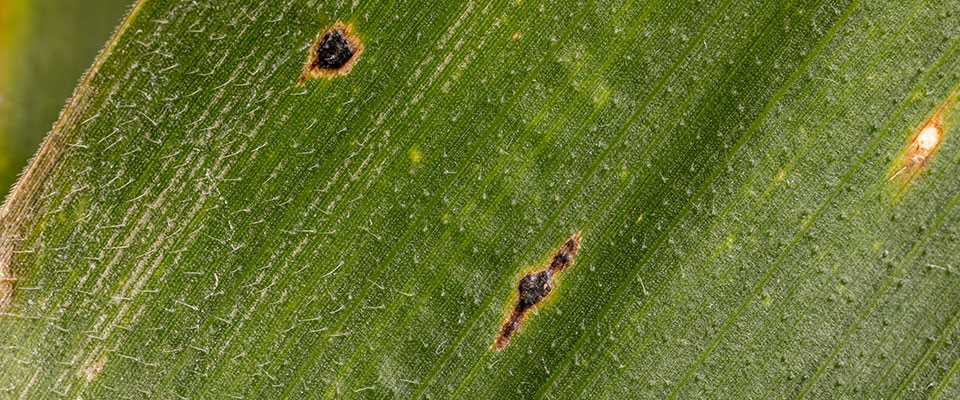
Tar spot develops as small, black, raised spots (circular or oval) on infected corn plants.
Four Kansas counties reporting tar spot in corn
Fungicides may be effective if disease is detected early, says K-State plant pathologist
At a glance: Tar spot, a fungal disease that hampered corn production in 12 Kansas counties last year, has been reported in four Kansas counties so far this year. Early detection is critical for reducing the negative impacts of the disease, says K-State plant pathologist Rodrigo Onofre.
More information: Rodrigo Onofre, 785-477-0171, onofre@ksu.edu
Related: K-State Agronomy e-Update | IPM Pipe (Reports of Tar Spot in the U.S.)
June 24, 2024
By Pat Melgares, K-State Research and Extension news service
MANHATTAN, Kan. – A fungal disease that hampered corn production in 12 Kansas counties last year is back.
Kansas State University plant pathologist Rodrigo Onofre said tar spot has already been found in four northeast Kansas counties – Doniphan, Atchison, Jefferson and Nemaha. Those four were among the 12 counties that reported tar spot in 2023, but the disease is showing up about a month earlier this time.
Thus, Onofre said, “now is the time to intensify scouting efforts.”
“If you wait until significant disease is in the upper canopy, a fungicide application may be too late (to help the crop),” he said. “The early onset of disease that we’re observing this year raises concerns about yield loss. Generally, early observations of tar spot have corresponded with high yield loss. The recent rains (in that region of Kansas) likely helped to promote development of tar spot.”
Onofre said tar spot develops as small, black, raised spots (circular or oval) on infected plants, and may appear on one or both sides of the leaves, sheaths and husks. Sometimes, he said, the spots may be confused with insect poop, but scraping the spot is an easy test to differentiate between a tar spot lesion and droppings.
Fungicides are an effective tool for controlling tar spot if they are timed well, according to Onofre.
“Research has shown that the best return on investment from a fungicide application on corn occurs when fungal diseases are active in the corn canopy,” he said. “A well-timed, informed fungicide application is important to reduce the disease’s severity when needed, and we recommend holding off until the disease is active in your field and corn is at V10-VT growth stages.”
He added that a second application might be needed between R1-R3 growth stages if the disease continues to spread. Scouting and disease monitoring are crucial for best disease control.
Thus far in 2024, tar spot has been found in bordering states Nebraska, Iowa and Missouri, as well as several counties in Indiana. In addition to the four Kansas counties already observed with the disease this year, tar spot showed up in Brown, Douglas, Jackson, Leavenworth, Marshall, Pottawatomie, Wabaunsee and Washington counties in 2023.
Updated maps on the spread of the disease is available online at https://corn.ipmpipe.org/tarspot.
More information also is available at local extension offices in Kansas.
***

K‑State Research and Extension is a short name for the Kansas State University Agricultural Experiment Station and Cooperative Extension Service, a program designed to generate and distribute useful knowledge for the well‑being of Kansans. Supported by county, state, federal and private funds, the program has county extension offices, experiment fields, area extension offices and regional research centers statewide. Its headquarters is on the K‑State campus in Manhattan. For more information, visit www.ksre.ksu.edu. K-State Research and Extension is an equal opportunity provider and employer.